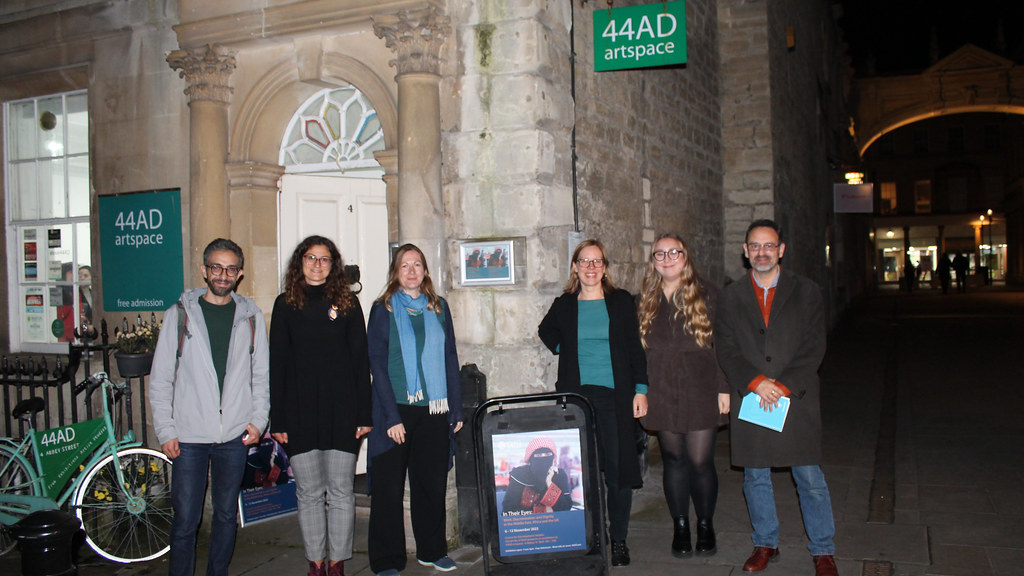A new exhibition has opened at the 44AD artspace in the City centre aiming to highlight the plight of people living in marginalised communities in the Middle East, Africa and the UK.
Featuring contributions from members of Bath’s Centre for Development Studies, the collection brings together accounts of daily life through photography and drama.
It includes visual narratives produced by garment sector workers in Jordan, urban residents in South Africa, asylum seekers in Bristol and displaced populations in South Sudan. It also documents a participatory mental health project in a Palestinian camp in Lebanon and a documentary film of a play produced by displaced youth in Jordan.
In Their Eyes
On the exhibition, which is at 44AD until Sunday 12 November (open daily 11am – 5pm), Dr Katharina Lenner explained: “Social science researchers are increasingly moving in the direction of helping to enable marginalised communities express their own perspectives and priorities, rather than simply letting them answer our preconceived questions.
“This can bring out unexpected themes and issues. But more than anything, it turns the people we do research with from passive voices into artists and storytellers , who can speak for themselves, and acknowledges that they are the true experts of their own lives. Sometimes this can help them create change in their communities. Photography and theatre are particularly powerful means to facilitate this, and this exhibition is testimony to that.
“At the exhibition, you can find out why garment sector workers in Jordan love watching their goats, how refugees in South Sudan design their shelters with available materials, what asylum seekers in Bristol value the most, and much more. Please come along and explore.”
The exhibition features six separate sections:
Garment Sector workers in Jordan
Garment workers earn extremely low wages in Jordan, which are typically insufficient to sustain a family. Employers prefer to hire unaccompanied women from South Asia, yet Jordanians, Syrians and other refugees also work in the sector. Interactions between the different nationalities and groups is typically limited.
The collection was collaboratively developed by the Bath team and led by Dr Katharina Lenner and Tamkeen for Legal and Human Rights, an advocacy organisation for migrant and refugee workers in Jordan.
Seven workers from different backgrounds documented daily life inside and outside the factories, and then selected and discussed their favourite pictures in group meetings designed to encourage exchange between different workers.
Neglect and the protection of refugee children in Amman
In 2021, a team from the University, led by Prof Jason Hart and Dr Mohammed Alruzzi, worked with organisations in Jordan and Palestine to learn more about the protection of refugee children.
One element of this work consisted of a theatre project with children from Sudan, Somalia and Yemen now living in Amman. Two Sudanese community researchers followed the project from start to finish, speaking regularly to the children.
At the exhibition, visitors can watch an evocative film all about the project and the dynamics it engendered.
Being human
Asylum seekers arriving in the UK currently face a hostile policy environment. Over the last 25 years, government welfare provision has diminished considerably and the lives of those waiting in the extended asylum application system have become heavily regulated.
In this exhibition, Bath’s Michelle James worked with asylum seekers capturing over 100 images which reflect some of the everyday challenges people experience while waiting in the system. The photographs presented offer a small selection of the output of a photovoice project carried out in Bristol.
Design and dignity during war in South Sudan
Conflict erupted in South Sudan in 2013. Since, over 400,000 have died. As soon as war started people fled to UN peacekeeping bases for protection, shelters known as ‘Protection of Civilian Sites’. A decade on, some people are still there.
Despite the horror of war and these sites, some South Sudanese invested time and money to make their shelters more beautiful. In some places they planted small gardens of flowers and mango trees, in others they found second-hand materials to build better floors, roofs and ceilings.
Photographer Dang Yoak, living in one site near Malakal, worked with Bath’s Dr Naomi Pendle to photograph and describe some of the shelters that he thought were the most beautiful.
Siyaqhubeka and living under the weight
‘Siyaqhubeka’ is an isiZula (South African) phrase which translates as ‘we continue, we move on’. This section charts the continuities of Apartheid’s spatial, social, cultural and discursive legacy.
By documenting how people navigate Johannesburg today, it sheds light on how present forms of injustice are connected to first-hand, intergenerational and social memories of collective violence that occurred during Apartheid.
The project, led by Bath’s Polly Winfield, brought together 16 individuals who live or work in downtown Johannesburg in a participatory photography project. They took photographs on smartphones as they went about their daily routines.
Qaderoon
This exhibition, brought together by Bath’s TCRG Hala Alaouie, presents snapshots from sessions carried out with Palestinians from the Burj El Barajneh Refugee Camp between 2008 and 2009, as part of the 'Qaderoon (‘we are capable’) Project'. This was a community-based participatory research project.
Over the course of a year, six facilitators and 23 Palestinian youth mentors facilitated 45 sessions on life skills with 290 Palestinian refugee children aged between 10 and 14. The exhibition centres on their experiences, but it also provides a unique view into the camp through their eyes.

